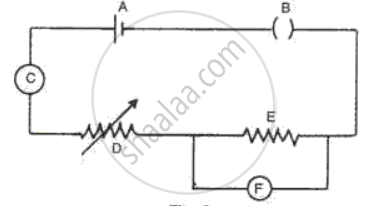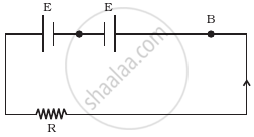Advertisements
Advertisements
Question
State microscopic form of Ohm’s law.
Solution
Current density J at a point in a conductor is the amount of current flowing per unit area of the conductor around that point provided the area is held in a direction normal to the current.
J = `I/"A"`
Drift velocity, `"V"_"d" = "eE"/"m" tau`
I = `"neAV"_"d" = "neA" ("eA"/"m") tau ...["J" = "I"/"A"; sigma = ("ne"^2 tau)/"m"]`
`"I"/"A" = (("ne"^2tau)/"m")`E
J = σE
APPEARS IN
RELATED QUESTIONS
Name the physical quantity whose unit is "ohm".
When a 12 V battery is connected across an unknown resistor, there is a current of 2.5 mA in the circuit. Calculate the value of the resistance of the resistor.
Fill in the following blank with suitable words:
Resistance is measured in .............. The resistance of a wire increases as the length ..............; as the temperature ..............; and as the cross-sectional area .............. .
Tick(✓) the correct choice in the following:
Ohm's law is applicable to
Fig. represents the circuit used for the verification of Ohm's law. Label the parts from A to F. state the function of each.

Two cells of same emf E but internal resistance r1 and r2 are connected in series to an external resistor R (Figure). What should be the value of R so that the potential difference across the terminals of the first cell becomes zero.
Two conductors are made of the same material and have the same length. Conductor A is a solid wire of diameter 1 mm. Conductor B is a hollow tube of outer diameter 2 mm and inner diameter 1 mm. Find the ratio of resistance RA to RB.
What is the resistance of a conductor through which a current of 0.5 A flows when a potential difference of 2V is applied across its ends?
Let the resistance of an electrical device remain constant, while the potential difference across its two ends decreases to one fourth of its initial value. What change will occur in the current through it? State the law which helps us in solving the above stated question.
The voltage - current readings of a certain material are shown in the table given below:
| Voltage (V) | 10 V | 20 V | 30 V |
| Current (I) | 2 A | 3 A | 4 A |
Study the table.
- State whether the conductor used is ohmic or non-ohmic.
- Justify your answer.
- State Ohm's law.
